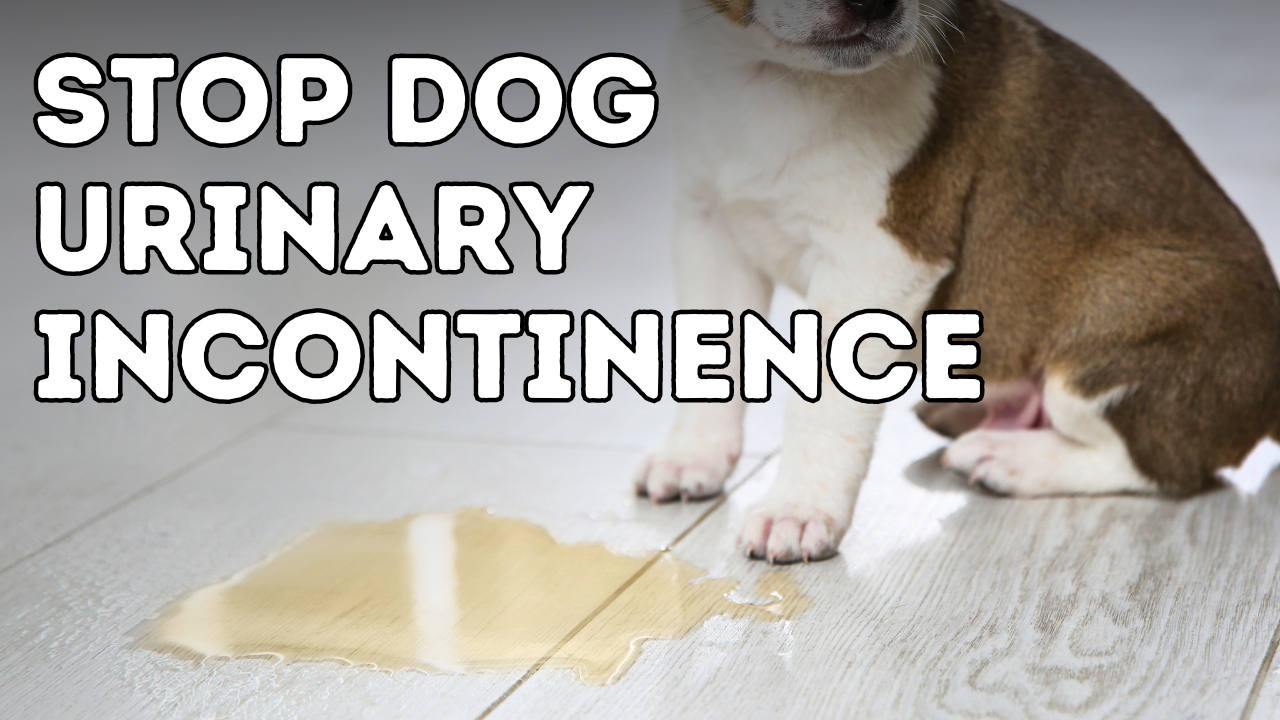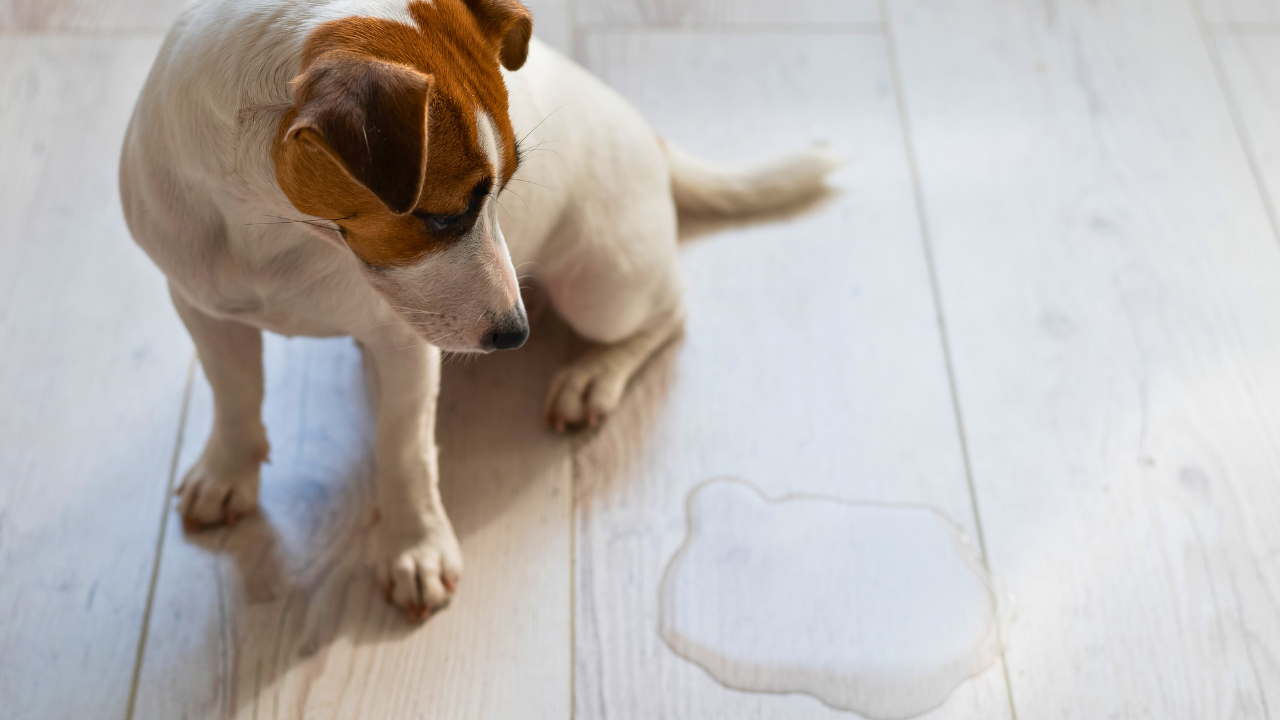How To Stop Dog Urinary Incontinence With Holistic Options

Urinary incontinence (leaking urine) is surprisingly common in many dogs. In spite of what you may think, most cases of urinary incontinence can be resolved with some fairly simple treatments.
Stop Dog Urinary Incontinence With our supplements- shop now
Dr Jones’ Urinary Support Chews for Dogs


Understanding and Treating Canine Incontinence: Natural Remedies for Your Dog’s Leaking Bladder
In this article, I will discuss the common signs and symptoms of canine incontinence, then cover the most important natural remedies you can use to treat your dog’s leaking bladder at home.
Identifying Canine Incontinence
The first step is to ascertain whether your dog is truly incontinent or if there’s another issue at play, such as a bladder infection or submissive urination. Incontinence is defined as involuntary urine leakage, which often occurs at night when your dog is relaxed or sleeping. Dogs with conditions like diabetes or kidney failure may drink excessively, making it difficult for them to go through the night without urinating indoors.
Common Causes of Incontinence
The most common occurrence of incontinence is seen in middle-aged spayed female dogs. These dogs have lost a source of estrogen necessary for maintaining bladder control. Other less common causes include bladder infections and spinal cord damage. Due to the variety of possible causes, I strongly recommend that you first visit your veterinarian to determine the most likely cause of your dog’s incontinence.
Your veterinarian can perform a physical exam, a urinalysis to check for infections, and blood work to assess organ function. If it is determined that estrogen-responsive incontinence is the likely diagnosis, your veterinarian may suggest using estrogen medication.
Natural Remedies for Estrogen-Responsive Incontinence
If your dog is diagnosed with estrogen-responsive incontinence, there are natural remedies you can try at home.
-
Glandular Supplements: Some glandular supplements can help your spayed female dog produce more natural estrogen. These are generally known as raw gland concentrates. One such product, available at health food stores, is called ‘Female Caps’ (Solaray). The recommended dose is 1/4 capsule per 10 lbs of body weight daily. Try this for 30 days to see if it’s effective.
-
Ground Flax Seed: This is a great source of plant estrogens. The recommended dose is 1 teaspoon per cup of food daily. Naturally increasing estrogen through flaxseed is a smart and simple strategy.
-
Soy Isoflavones: Another good source of estrogen, these can be purchased as an extract under the brand name Genista. The recommended dose is 1/4 capsule per 10 lbs of body weight daily. Use this for 30 days to evaluate its effectiveness.
Stop Dog Urinary Incontinence With our supplements- shop now
Dr Jones’ Urinary Support Chews for Dogs
Addressing Incontinence Related to Spinal Issues
Back injuries can sometimes put pressure on the nerves that control the bladder. To alleviate this pressure, you can try the following technique:
- Hold your thumb and index finger, locate the dip between the vertebrae on either side of your pet’s backbone, and press straight down for two seconds, then release. Start at the middle of the spine and go down to the tail. This helps keep the spine flexible and may release any excess pressure on the nerves.
Acupressure Points for Bladder Control
There are specific acupressure points that can influence bladder control and the adrenal glands:
- BL1: Located on the inside of the eye.
- BL13, BL14, BL15: Located along the spine at the level of the front shoulder.
- BL67: Located on the outside of the lateral toe on the rear foot.
- SP6: Located on the inside of the back leg above the hock.
- SP10: Located just above the knee.
Apply pressure to each point for 1 minute twice daily for 2 weeks. If this seems to help regain bladder control, continue once a week thereafter.
If your dog is incontinent, take comfort in knowing that this can likely be easily remedied. For spayed female dogs, the most likely cause is hormonal, with the diagnosis often being estrogen-responsive incontinence. With the natural remedies and techniques I’ve outlined, you can effectively manage and potentially resolve your dog’s incontinence at home.

P.S. If you enjoyed this article, I encourage you to sign up for my newsletter where you’ll get my free book and videos on how to heal your pets at home with my top natural remedies. The key to having a healthy dog or cat is knowing what to do to prevent common diseases in the first place, including what to feed, which vaccines to give or avoid, and what natural treatments can be used to treat chronic illnesses like allergies. I’ll show you exactly what you can do immediately to both prevent and treat diseases in your dog or cat, using my holistic tips and remedies with simple, easy-to-follow instructions.
Also food can cause incontinence for some dogs. My 15 years old GSD only leaks after she eats chicken.
My 5 year old female yellow lab has been incontinent since birth. We had her spayed as a puppy and had her get spinal adjustments. She continued to leak. She has been on multiple medications since 12 weeks old. As time goes on it won’t work. She had an ultra sound last week and we were told she has an ectopic ureter. The surgery only has a 50% success rate at a cost of $3500.00. I am torn on what to do?
My little yorkie that passed away leaked since she was a puppy. The onstart was after she was spayed too early. The Vet that I took her to after she was spayed put her on Des Ous I had to give it every day for a long time, then reduced it to 0.1 daily which kept her dry until she passed away
I adopted my female aussie-cattle dog mix when she was 8. She had leakage problems when she came to me. I tried every single holistic solution suggested. My vet insisted that Proin is not dangerous. Have her on 50 mg’s, it worked but is now failing. I don’t know what to do!!
How long does it take for flaxseed oil to start working? My GSD has had bladder leak issues ever since I got her spayed. I’m about ready to put her down as life must be miserable. These vets over vax so their immune system attacks itself and then pressure you to spay them ending up with a whole new set of problems.
Until the desired outcome is achieved.
What do you think of DHEA for female or male dog incontinence?
We do have better option, this article can help:
Urinary incontinence (leaking urine) is surprisingly common in many dogs. In spite of what you may think, most cases of urinary incontinence can be resolved with some fairly simple treatments. In this article I will discuss the common signs and symptoms of dogs being incontinent, then cover the most important natural remedies that can be used to treat your dog’s leaking bladder at home.
The first thing to do is ascertain that it really is incontinence, and not a bladder infection or submissive urination. Incontinence is defined as involuntary urine leakage, and this often occurs at night when your dog is relaxed or sleeping. Dogs with diabetes or kidney failure may drink excessively, and then be unable to go through the night without urinating in the house. The most common occurrence is in middle-aged spayed female dogs. They have lost a source of estrogen that is needed to maintain bladder control. Other less common causes include bladder infections, and spinal cord damage.
As there can be several causes, you should first visit your veterinarian to determine the most likely cause. They can perform a physical exam, a urinalysis to check for presence of infection, and blood work to check organ function. If it is determined that estrogen responsive incontinence is the likely diagnosis, then your veterinarian may suggest using estrogen medication.
Some glandular supplements can help your spayed female dog produce more natural estrogen. These are generally known as raw gland concentrates. One product available at health food stores is called ‘Female Caps’ (Solaray). The dose is 1/4 capsule per 10 lbs of body weight daily. This can be tried for 30 days to see if it will be effective.
Naturally increasing estrogen is a smart and simple thing to do. Ground flax seed is a great source of plant estrogens ” the dose is 1 teaspoon per cup of food daily. Soy isoflavones are another good source of estrogen. These can be purchased as an extract under the brand name Genista. The dose is 1/4 capsule per 10 lbs of body weight daily. Use for 30 days to see if they are effective.
Back injuries sometimes put pressure on the nerves that control the bladder. Hold your thumb and index finger and locate the dip between the vertebrae on either side of your pet’s backbone. Press straight down for two seconds then release. Start at the middle of the spine and go to the tail. This helps move the spine, keeping it flexible and may release any excess pressure on the nerves.
There are acupressure points that control the bladder as well as influencing the adrenal glands. BL1, located on the inside of the eye; BL13, BL14, BL15, located along the spine at the level of the front shoulder; BL67, located on the outside of the lateral toe on the rear foot; SP6, located on the inside of the back leg above the hock; SP10, located just above the knee. Put pressure on each of the points for 1 minute twice daily for 2 weeks. If this appears to be helping regain control, repeat the pressure once per week.
If your dog is incontinent, take comfort in knowing that this can likely be easily remedied. If you have a spayed female dog, the most likely cause is hormonal, with the diagnosis being estrogen responsive incontinence.
My dog is a male has not been desexed 13 years honey helps heard about corn silk don’t know dosage
Regarding your male dog, the article mentions corn silk as a potential remedy for urinary incontinence. Corn silk is known for its anti-inflammatory properties and may help soothe the bladder, making it useful for urinary tract issues.
As for dosage, it’s recommended to start with a 1/2 teaspoon of dried corn silk per 10 lbs of body weight. This can be added to your dog’s food.
Doctor, I looked for the Female Caps from Solaray and it seems they took it out of the market. They have one called: Female Hormone Blend, I don’t know if it’s the same or not, I don’t see glandulars in that formula but lots of herbs that I don’t know if they are safe for my chihuahua. Could you please let me know if there is an equivalent in the market of the “Female Caps” in other brand? Or if the “Female Hormone Blend” of Solaray is safe to give it to her?
Here is the link the ingredients: https://a.co/d/iDU7rvc
Thank you so much!
Id love to know now the answer to this also!
Solaray’s Female Hormone Blend SP?7C—which includes herbs like black cohosh, dong quai, saw palmetto, and wild yam—is formulated for human female hormonal support and has not been tested or deemed safe for dogs.
Instead, for your chihuahua’s incontinence or hormonal needs, there are pet-specific options. For example, Vet Classics Bladder/Incontinence Support for Dogs contains phytoestrogens and botanicals designed for bladder health and has helped many dogs with issues similar to what you described